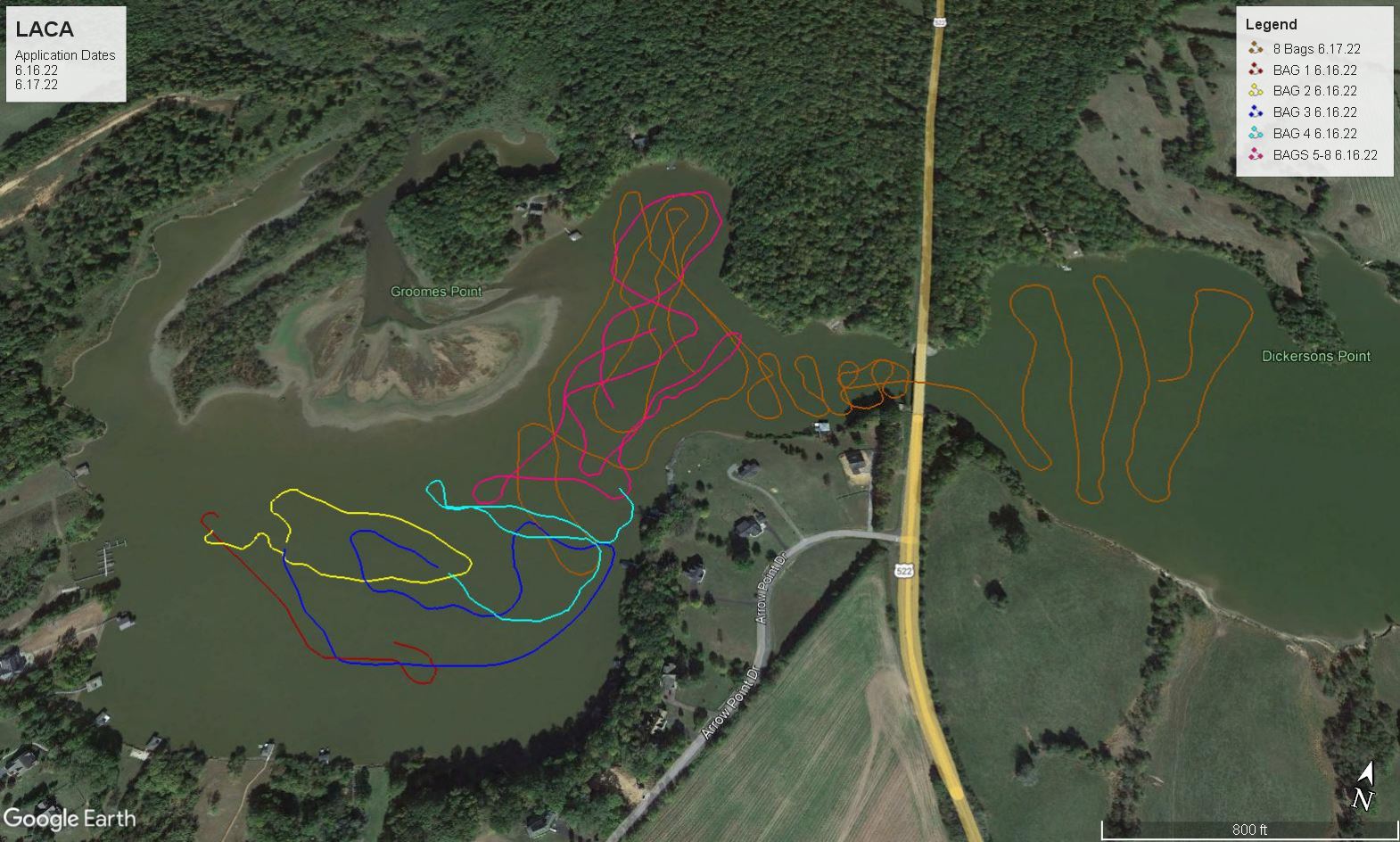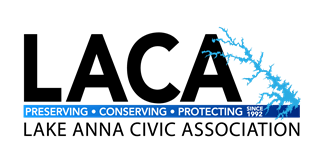Cyanobacteria Mitigation Program Application Event #1
Area of Interest (AOI)-Pamunkey
Application dates: June 16-17, 2022
Post-application monitoring dates: June 18-20, 2022
Application Tracks - GPS tracks of application locations on 16 and 17 June 2022
AOI Pamunkey

Data Plots
LACA monitors the lake prior to, during, and after each application event. LACA collects field parameters using a YSI ProDSS handheld instrument. The primary field parameters monitored by LACA include water temperature, pH, specific conductivity, and dissolved oxygen. We also collect water samples for analysis using LACA owned instruments. These instruments provide data on the amount of chlorophyll (CHL) and phycocyanin (PC) in each sample. Chlorophyll is a chemical pigment used by plants and cyanobacteria to produce energy through the process of photosynthesis. Phycocyanin is a chemical pigment only found in cyanobacteria. The instruments we use provide us data on the concentrations of each pigment in the samples we collect. We use these data, along with the field parameters collected with our ProDSS handheld device, to give us indications of the concentrations of cyanobacteria in the water. The images below provide the pH and dissolved oxygen (DO) field parameters data over a fie day period for each sampling site in AOI Pamunkey.
Note that the images below are thumbnails - click on an image to bring it into the view and then click on it again to get to a full page image. You can save a plot to your computer if you right-click on the image and select "Save Image As" .
The pH and DO data prior to the application of Lake Guard Oxy indicated that a cyanobacteria bloom was imminent in AOI Pamunkey. This conclusion is supported by high pH levels (some in the range of 9.5 or greater, levels that are unsafe for fish and aquatic vegetation) and very high levels of DO. High DO % levels are indicative of high levels of photosynthesis. The DO % data combined with high pH and increasing levels of phycocyanin are strong indicators that a cyanobacteria bloom was imminent in AOI Pamunkey. The data plots show significant decreases in each of these data parameters after the application of Lake Guard Oxy.
Complicating the analysis of post application data is the fact that the Lake Anna watershed had up to 3.5 inches of rain on the evening of 16 June (day 1 of the application event). The significant rain event caused a "flushing" of upstream areas and significant inflows into AOI Pamunkey. These inflows most likely contributed to the decrease in pH levels and may have "flushed" cyanobacteria populations further downstream. There is no way to quantify the contribution of the inflows versus the Lake Guard Oxy application. Everyone must understand that this is a pilot demonstration project, an experiment, that is being conducted in a living ecosystem subject to events seen everyday in nature such as rain, wind, and heat extremes. We are conducting an experiment in a complex system with many variables. The data we collect will be instrumental in developing strategies for future mitigation efforts focused on controlling the concentrations of cyanobacteria in Lake Anna.
LACA continues to monitor AOI Pamunkey, and each of the other AOIs for cyanobacteria population growth and all of the data will be considered in our project report to be developed after the 2022 recreational season.
Data file - Microsoft Excel workbook
Cumulative data log for 2022 Cyanobacteria Mitigation Program
Observations and Insights
LACA project managers collected several observations and insights from the first application event. These observations and insights have informed our planning for application events 2 and 3 in July and will be researched further during the remainder of project activities. Please direct questions or comments on these observations and insights to kicktheHAB@lakeannavirginia.org.
AOI Details and Product Application Plan: AOI Pamunkey covers an area of approximately 200 acres, 80 acres west of the route 522 bridge and 120 acres east of the route 522 bridge. Our application plan was to disperse 4 pounds of product per acre over a 2-day period (2 pounds per day) for a total of 800 pounds of the Lake Guard Oxy product. The product was dispersed each day using wind direction and speed and other environmental considerations to determine dispersal tracks.
Day 1 Recap: Day 1 dispersal operations took place under partly cloudy skies with mild winds from the west/northwest. Water conditions were calm with Secchi disk readings of 0.35 - 0.45 meters in most areas of the AOI. Field parameters taken before the product was applied indicated moderate cyanobacteria population densities and activities with surface pH levels above 9.0, dissolved oxygen above 10.5 mg/L and dissolved oxygen percentages greater than 135%. LACA's lab analysis of water samples taken prior to product application had phycocyanin levels averaging 7,780 radiance fluorescence units (RFU), chlorophyll levels averaging 15,450 RFUs across the AOI for an AOI average ratio of 0.50. These parameters all indicate moderate, pre-bloom cyanobacteria activities in place prior to product application.
Day 2 Recap: There was very heavy rainfall in the Pamunkey Creek watershed on the evening of June 16th and conditions in the creek were drastically different when we arrived for dispersal operations on Day 2. There was no discernable (visual) water flow on Day 1 but the rainfall inflows created a strong downstream flow on Day 2. There was significant mud, tree limbs, and other vegetation seen in the water and Secchi disk readings across the AOI were 0.05 meters. Tracks for the dispersal of the Lake Guard Oxy product were adjusted based on the conditions observed. Field parameters taken before the product was applied on Day 2 showed surface pH levels at 6.4, dissolved oxygen at 4.7 mg/L and dissolved oxygen percentages of 54.5%. LACA's lab analysis of water samples taken prior to product application on Day 2 had phycocyanin levels averaging 2,770 RFUs and chlorophyll levels averaging 6,670 RFUs across the AOI for an AOI average ratio of 0.42. Phycocyanin and chlorophyll levels west of the route 522 bridge showed substantial decreases with phycocyanin levels averaging 275 RFUs and chlorophyl levels averaging 2,335 RFUs for an average ratio of 0.12 west of the route 522 bridge. This is an important data point given that a majority of the product was dispersed west of the route 522 bridge.
Water Monitoring Recap: LACA monitored lake conditions in AOI-Pamunkey for three consecutive days after the second day of product application. All data are available in the data sheet at the link provided above in the Data file section.
Observations and Insights:
- Phycocyanin levels were down significantly after Day1 (96% at stations west of the route 522 bridge and 14% east of the bridge)
- Phycocyanin levels remained low after Day 2 (down 90% at stations west of the route 522 bridge and 71% east of the bridge)
- Phycocyanin levels remained low after Day 4 (down 83% at stations west of the route 522 bridge and 44.5% east of the bridge)
- Phycocyanin levels remained low after Day 5 (down 69% at stations west of the route 522 bridge and 37% east of the bridge)
- In non-treated areas of the upper part of Pamunkey Creek outside of the AOI, phycocyanin levels were up as much as 160% after the rainfall event on June 16th
- LACA's monitoring data as of June 30th indicates that the best water quality and cyanobacteria parameters in the upper Pamunkey Creek area are at the stations in the treated areas west of the route 522 bridge
- The rainfall event on the evening of June 16th complicates our ability to assess effects from the application of Lake Guard Oxy in AOI-Pamunkey. It is clear that some combination of Lake Guard Oxy and the rain inflows caused a significant reduction in cyanobacteria levels across the entire area of AOI-Pamunkey.
- The Lake Guard Oxy product was seen on the surface through Day 5 of the application event. The product developer's statements that the product remains viable for 24-72 hours and then dissipates into water and oxygen are consistent with our observations.
- There were no adverse environmental effects from the Lake Guard Oxy noted from June 16th through June 20th. LACA observed the entire length of Pamunkey Creek from the splits to the flats west of the route 522 bridge each day from June 16th through June 20th. LACA observers saw 1 dead striper in Pamunkey Creek on June 20th.
Next Steps:
- LACA closely monitors phycocyanin and the ratio of phycocyanin to chlorophyll across the entire upper Lake Anna area. Data indicate that the treated areas in AOI-Pamunkey remained below our level of concern thresholds while other areas of the upper lake trended higher due to higher water temperatures, sun angle, and other environmental conditions. The Virginia Department of Health (VDH) had not declared a recreational advisory for any area of Lake Anna at the completion of Application Event #1 but LACA data indicates that the North Anna River and Terry's Run are trending closely to 2021 data. These two tributaries went under VDH advisory in July of 2021 so they will be treated during our July mitigation activities.
- Lessons learned from Application Event #1 will be applied to July and August application events.
- LACA will remain on schedule for July application events. AOI-Goldmine and AOI-Duckinhole will be treated with Lake Guard Oxy on 14 and 15 June. AOI-Pamunkey will receive a second treatment on 18 and 19 July. AOI-Beverly will also be treated on 18 and 19 July.
